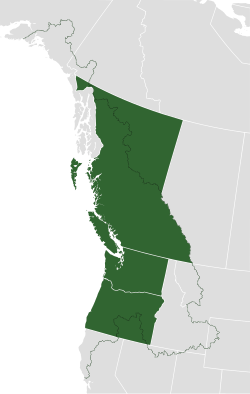
Back Kaskadiya Aymara Cascàdia Catalan Kaskádie Czech Cascadia Welsh Kaskadien German Cascadia Spanish Kaskadia Basque Cascadie French Cascadia Galician Kaskádia Guarani
Cascadia | |
|---|---|
 Boundaries of the bioregion with respect to current political divisions (Washington, Oregon, and British Columbia). | |
| Largest city | Seattle |
| Official languages | English (de facto) |
| Demonym(s) | Cascadian |
| Area | |
• Total | 1,384,588 km2 (534,592 sq mi) |
| Population | |
• 2022 estimate | 17,250,000 |
• 2020 census | 17,134,999 |
| GDP (PPP) | 2018 estimate |
• Total | US$1.1 trillion estimate[1][2][3] |
• Per capita | $69,153 estimate |
^ a. *Statistics are compiled from US and Canadian census records by combining information from the states of Washington, Oregon and the province of British Columbia. | |
The Cascadia movement is a bioregional independence movement based in the Cascadia bioregion of western North America. Potential boundaries differ, with some drawn along existing political state and provincial lines, and others drawn along larger ecological, cultural, political, and economic boundaries.
The proposed country or region largely would consist of the Canadian province of British Columbia and the US States of Washington and Oregon, including major cities Seattle, Vancouver, and Portland. When all parts of the bioregion are included, Cascadia would stretch from coastal Alaska in the north into Northern California in the south, and inland to include parts of Idaho, Montana, Nevada, Utah, Wyoming, and Yukon. More conservative advocates propose borders that include the land west of the crest of the Cascade Range, while some advocates propose borders as far north as Alaska and the Yukon region.
As measured only by the combination of present Washington, Oregon, and British Columbia statistics, Cascadia would be home to more than 17 million people, and would have an economy generating more than US$1.1 trillion worth of goods and services annually. This number would increase if portions of Northern California, Idaho, and Southern Alaska were also included. By land area Cascadia would be the 20th largest country in the world, with a land area of 534,572 sq mi (1,384,588 km2), placing it behind Mongolia and ahead of Peru.[4] Its population would be similar in size to that of Ecuador, Zambia, Cambodia, or the Netherlands.
- ^ "U.S. Bureau of Economic Analysis (BEA)". bea.gov. Archived from the original on August 6, 2016. Retrieved March 9, 2018.
- ^ "U.S. Bureau of Economic Analysis (BEA)". bea.gov. Archived from the original on August 6, 2016. Retrieved March 9, 2018.
- ^ "Economic Accounts - BC Stats". gov.bc.ca. Archived from the original on March 9, 2017. Retrieved April 12, 2012.
- ^ "The World Factbook". CIA.gov. Central Intelligence Agency. Archived from the original on January 31, 2014. Retrieved August 4, 2014.